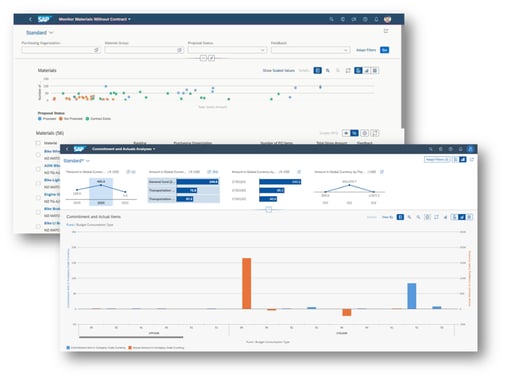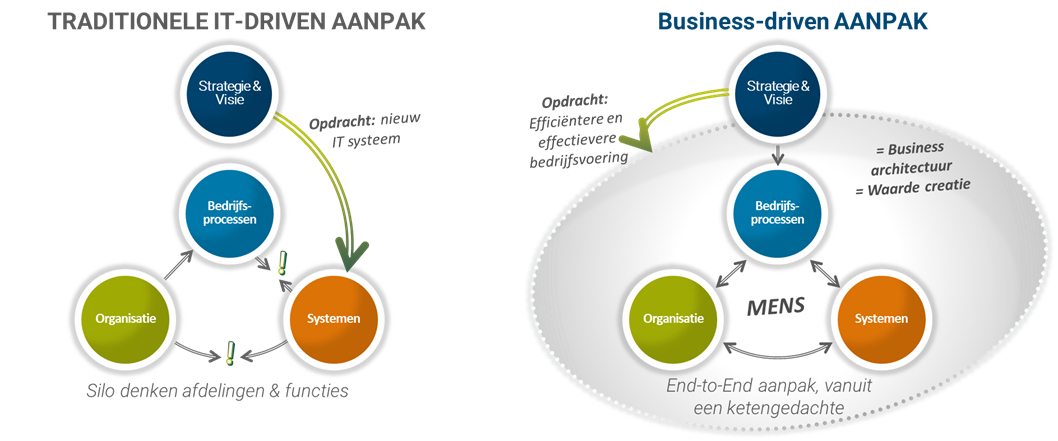Preventing SAP S/4HANA Implementation Errors
Last edited on Jan, 21 2025 05:55:05 PM
Reading time: 3 minutes
Written by Patrick Beks
Table of contents

Since the first release of SAP S/4HANA in 2014, SAP's latest ERP solution has undergone significant development. What started as Simple Finance, a 'next-gen' financial solution, has now become a completely revolutionary ERP system. Although the system is certainly not new, in practice incorrect implementation choices are sometimes made.
These wrong choices are made because traditional implementation methods do not always fit with such a revolutionary and modern ERP platform. It's a shame, because the power of S/4 is not used optimally. Curious about these errors? And more importantly: how can you prevent them? You can read it in this blog.
Pitfall 1: Unused analytical insight
To understand this implementation pitfall, you first need to know about IT and database architectures. I'll explain why. SAP had great ambitions with its vision on S/4. In addition to robotizing non-value-adding administrative actions, through RPA and Machine Learning, you can think of more real-time and even predictive insight.
All these ambitions have one thing in common: they require a new user interface that controls for exceptions and enables more analytical functions. To make that possible, a whole new database was needed.
The two traditional IT systems in SAP
Traditionally, there are two systems, namely Online Analytical Processing (OLAP) and Online Transactional Processing (OLTP). The main difference between the two systems is the purpose. An OLAP system is designed to quickly process large amounts of data, allowing users to quickly analyze multiple dimensions of data for decision-making and analysis. On the other hand, OLTP systems are intended to process large amounts of transaction data from multiple users. They work with relational databases and can update small amounts of data in real time. Although both systems are well tailored to their specific tasks, the separation also brings disadvantages, such as the lack of real-time data analysis and reactive reporting. It is important to strive for analytical guidance on exceptions and automation of the operational process for operational excellence.
SAP HANA as new database
SAP therefore faced the enormous challenge of uniting the properties of both systems into one. This ambition resulted in the HANA database, which provides optimal analytical insight.
How did SAP achieve that? Magic? Well, not really. The solution lay in a combination of the use of an in-memory database and a column-based way of data processing. The latter allows data to be retrieved efficiently, because only relevant data is retrieved instead of entire records row-by-row. The result is an extremely simplified table structure. Large amounts of data can be stored in one table without sacrificing data processing speed. Traditional aggregate tables have become obsolete. The 'universal journal' tables within Finance are the best example of this.
Back to the pitfall: existing SAP software had to be optimized to use the new, simplified tables to take full advantage of the power of HANA. However, SAP is so rich in functionality that not everything could be done at once. Large parts have already been improved, but new functionality is still offered with every release. Naturally optimized for HANA.
At Emixa we are continuously aware of the latest developments and roadmaps from SAP. This makes us an ambassador of SAP's vision for automation and greater analytical insight. Parties that do not do this and rely on outdated knowledge and implementation methods are likely to fall into the trap of using "old" functionality or reduced ease of use. It's a shame because you will not get the most out of the modern IT platform that SAP offers with S/4HANA!

Figure 1. An example of how transactional data is directly available in analytical views
Pitfall 2: Thinking in large projects
Traditional implementation methods often involve large projects. Preferably according to the waterfall method with clear frameworks and objectives in advance from the IT department.
The IT department often finds changes in the ERP landscape (such as innovations) scary, works slowly and is essentially intended to maintain what is already there. The well-known slogan “Don't fix what ain't broke” perhaps best describes this traditional attitude.
This is in stark contrast to increasingly demanding business operations. The established order in particular suffers from the inhibitory lead and loses out to quickly innovating start-ups or scale-ups. The speed at which (IT) innovations occur is also a problem with this traditional way of thinking. A transformation project that lasts years is no longer profitable. By the time the organization completes the implementation, the system is outdated.
A low-code platform provides flexibility
What is needed is a working method that prefers flexibility over project stability and risk-averse behavior. It also sets technical requirements for the ERP solution. Due to the fact that SAP is no longer one modular system, but behaves as a technology platform, technical depth and integration complexity are eliminated. The approach, which is based on best practices, guarantees standardization and harmonization for where “good” is good enough. Speed and flexibility are offered specifically for competitively distinctive processes that belong to the innovation layer in the system landscape, for example through Mendix as a low-code platform.
The result: a modular, flexible and agile landscape and a 'Composable ERP'. This has one solution per main process and therefore limits the number of suppliers. Suppliers become strategic partners. They understand the situation, the challenges and ambitions.
Pitfall 3: IT-driven S/4HANA implementations
In line with pitfall 2, it often happens that implementations are IT-driven. The existing system is outdated and no longer supported. A simple business case is made or business risks are weighed and the assignment in such situations is “implement a new ERP”.
The problem with such an assignment is that it does not sufficiently transcend silos. The assignment does not provide room for a business architecture based on value creation.
From IT-driven to business-driven
What is needed is a business-driven approach with a mission such as: “more efficient and effective business operations”. Only then will an End-to-End approach be created based on a chain idea. Key officers are needed from every department with a real understanding of the business processes and the associated challenges.

Figure 2. From IT-driven to business-driven.
Make the most of SAP S/4HANA
These pitfalls are not intended as demotivators. On the contrary, if you recognize these pitfalls correctly, you can take appropriate measures.
Nevertheless, these pitfalls reveal that a large-scale ERP implementation should not be underestimated. The right (implementation) partner (after all, we have seen that partnership goes further than just implementation) is crucial. This prevents these and other pitfalls and thus increases the return you get from your investment.
Get in touch
Ready to make a business change? At Emixa, we'd be glad to share our comprehensive insights. Contact us to discover how our approach can help your organization thrive in the cloud era. Let's embark a journey towards enhanced efficiency and effectiveness together!

Patrick Beks
As Director Technology and innovation Patrick plays a crucial role in driving technological innovation, fostering a culture of continuous improvement, and maintaining Emixa's competitive edge in the market.
Last edited on Jan, 21 2025 05:55:05 PM
Reading time: 3 minutes
Written by Patrick Beks
Also see..
OverviewFuture-Proof Project Management: Emixa Prefab for SAP S/4HANA
Emixa has developed specialized SAP add-ons designed for project-based organizations, with a strong...
Read more ⟶How SAP Signavio Enhances S/4HANA Migration & Process Standardisation
Do you find that inconsistent processes often create confusion, errors, and delays in your...
Read more ⟶Change management: People at the center of SAP S/4HANA implementations
In the rapidly evolving world of business operations, digitalization, such as an SAP S/4HANA...
Read more ⟶

